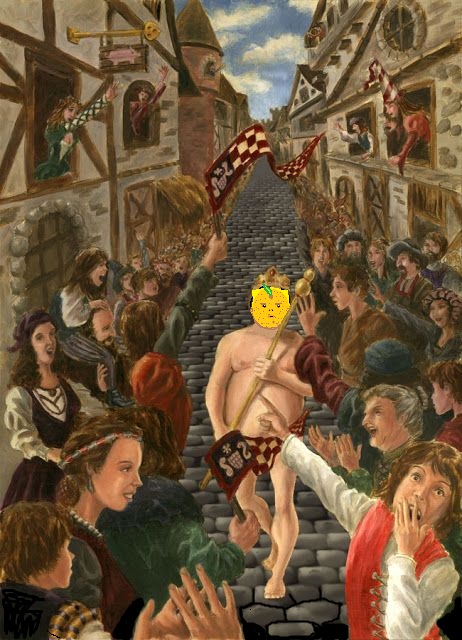

Obsessed with crowd sizes and complete control, he surrounds himself with tush-kisser sycophants as our Nation is ready to move forward because we are not going back.
Kim Jong Un and Putin's
love letters are kept between the pages—
of the Art of the Deal
|
Author Notes
sycophant= self-seeking flatterer
The Emperor's New Clothes is a book about an emperor who has an obsession with fancy new clothes, and spends lavishly on them, at the expense of state matters. One day, two con-men visit the emperor's capital. Posing as weavers, they offer to supply him with magnificent clothes that are invisible to those who are incredulous.
The gullible emperor hires them, and they set up looms and pretend to go to work. A succession of officials, starting with the emperor's wise and competent minister and ending with the emperor himself, visit them to check their progress. Each sees that the looms are empty but pretends otherwise to avoid being thought a fool.
Finally, the weavers report that the emperor's suit is finished. They mime-dress him and he sets off in a procession before the whole city. The townsfolk uncomfortably go along with the pretense, not wanting to appear inept or stupid, until a child blurts out that the emperor is wearing nothing at all. The people then realize that everyone has been fooled. Although startled, the emperor continues the procession, walking more proudly than ever.
HAIBUN is a Japanese poetic form that combines haiku with prose. It's in present or past tense. The subject matter can be autobiographical, a travel journal, a slice of life, a memory, a dream, or a short sketch of a person, place, or event. Topics can be about life, love affairs, human concerns, and experiences. The point of view is first person (the author's eyes), or third person (he/she). Use imagery, sensory, and concrete details. Length varies from very brief (1-2 sentences) with one haiku, to long prose entries with interspersed haiku.
The prose tells the story, gives information, defines the theme, creates a mood through tone, and provides a background to spotlight the haiku.
The haiku moves the story forward, takes the narrative in another direction, adds insight or another dimension to the prose, resolves the conflict in an unpredictable way, or questions the resolution of the prose. Prose is the narrative and haiku is the revelation or the reaction.
guidelines for writing haibun
for Haibun examples click here
for more information click here
Thank you very much for reading and reviewing my poem,
Gypsy
Pictures from my Pinterest account. I don't use a presentation template, the complete presentation and poem created by Gypsy Blue Rose COPYRIGHT@2024
|
|




